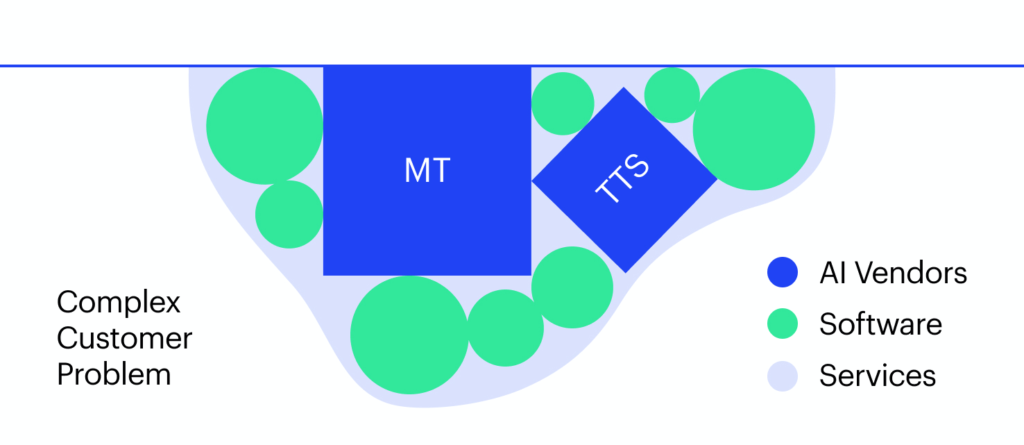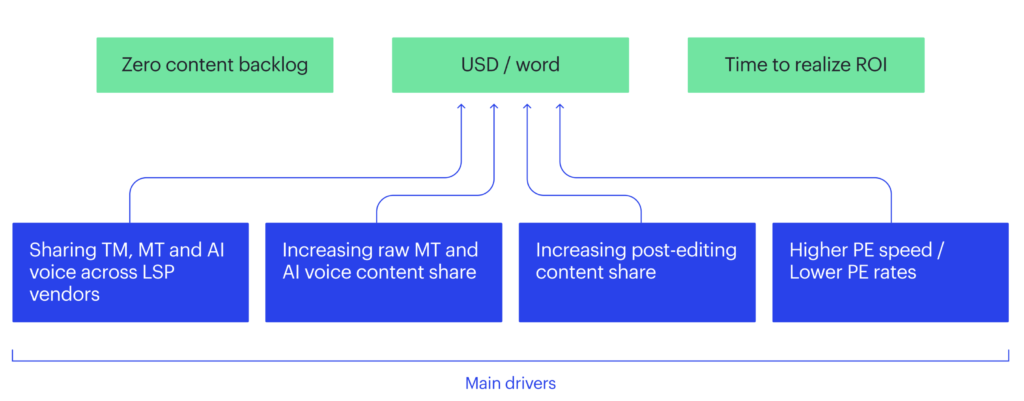Maximizing the Benefits of Machine Translation for Business Problems
This article looks at solving complex business problems using artificial intelligence (AI) tools, such as machine translation and other technologies.
You may feel overwhelmed by your current challenges. You may have a tiny budget to translate 60 hours of instructional videos per month (even per week) into 20 languages. You may have large volumes and a short turnaround time, and you need to make process improvements immediately to keep up with what is coming down the pipeline.
There are numerous AI tools readily available. Nevertheless, there is always a difference between what you need and what AI can provide. Software tools can fill the gap but may not bridge it completely. As a result, additional services may be necessary to fully meet your needs, whether from your in-house crew or outsourcing. Ultimately, you will need someone to know how to pull those levers.

This series of articles will look at AI supply and demand, considering everything outside the “AI Vendor” squares (Figure 1). In other words, what do you need in addition to machine translation currently available on the market? We will explore this from the following perspectives:
- Reasons for using MT, including faster translation, lower cost, and larger volume
- The distinction between localization and real-time translation use cases
- Importance of understanding the return on investment (ROI) from using MT
- The three main outcomes from MT in localization
- Sources for USD/word gains
- Additional factors to consider when evaluating the ROI from using machine translation
Reasons to use MT beyond the fear of missing out
Machine translation can provide numerous benefits to businesses, including the ability to translate content faster, at a lower cost, and in larger volumes. It can also help to clear out growing backlogs of content and improve the quality of translations. In some cases, you may need to see a preliminary translation to make informed decisions, which may also drive the use of MT. These are just a few reasons businesses may use MT to solve translation needs. Moreover, there is, of course, the particular fear of missing out: everyone uses MT, so we also need to use MT. Generally, however, there are business cases that call for it:
- Translate faster
- Translate cheaper
- Translate more than the budget allows
- Eliminate a growing backlog
- Improve translation quality
- Gisting, meaning providing visibility into a preliminary translation to make decisions faster.
Localization vs. real-time translation
Before implementing machine translation (MT), it is essential to consider whether the primary use case is localization or real-time translation, as this will affect the decisions made going forward.
Localization involves using MT to solve the same problems as the localization team would with human translation but better. A typical setup does not exclude a human from the mix. There are integrations with the TMS and workflows that involve humans. In localization, there are a number of assets to customize MT, including glossaries, translation memories, and other assets. You typically work with human translators, a post-editing workflow, training data, and existing business relationships with LSPs. Working with providers adds complexity to the process by introducing extra steps.
In contrast, real-time translation use cases involve working with customer service, global community content, internal community content, digital workplace tools, and Microsoft Office tools. Real-time machine translation solutions often focus on providing multilingual customer and employee experience. Think of on-demand translation for knowledge bases, tickets, live chats, chatbots, and user-generated content. These solutions require integrations with the software platforms of end-users, such as Salesforce or ServiceNow. Since real-time scenarios rarely involve professional linguists, much less high-quality data is available for customizing MT. The MT needs to be improved based on implicit and explicit feedback from end-users, which requires different MT customization tools.
This series of articles focuses primarily on the localization use case.
Machine translation ROI (for localization use-case)
Understanding and measuring the return on investment from using machine translation is essential. After implementing MT, you will need to be able to answer the question of what the ROI was. It is helpful to have a simple answer to this question because you may need to discuss it with people who are not directly involved in localization or understand the processes that go into it.
Three main MT ROI drivers for Localization
We suggest using the following ROI framework, which considers three main outcomes from MT in localization as follows:
- Achieve a zero-size backlog
Many departments may ask to have something translated, and you keep telling them: “Sorry, not today. Maybe next year.” MT in localization can reduce the put-offs and bring new value to other departments instead.
- Reduce translation costs
Using MT in localization dramatically reduces your overall USD/word rate if you have in-house translators.
- Implement changes faster
You can decrease the time to get the ROI, which can be important in a number of cases. In the case of a crisis, for example, you may need ROI in a month or two, not in a year or three.
Reduce costs by sharing the MT assets
Typically, we see USD/word gains from four sources. The first is the ability to share your AI assets among different LSPs or departments. In doing so, you are pushing parties to a similar productivity level (much like sharing TMs) and improving vendor management for yourself at the same time.

You can consider a broader range of language service providers. If you give them good MT, they may have better rates for you.
As MT gets better, translate more content through raw MT
The second source of gains for USD/word is in the increased sharing of content that goes via raw MT, a process that does not involve humans. Raw MT is constantly improving, and the need to push some content through post-editing decreases. It also allows you to push new types of content to post-editing. For example, you may decrease pushing documentation to post-editing and replace it with marketing content.
Note that looking at that post-editing effort may be misleading from the buyer side. Because you always push some content outside of post-editing, remember to consider this. You may increase MT quality dramatically and still have the same rates, but some content will not be post-edited.
Apply MT post-editing even to important content
The third factor comes with increasing the share of post-edited content. There is a straightforward, technical way to check for this. Once your MT improves, if you run analytics in the TMS, you see that the number of edits for machine-translated content is less than for many fuzzy matches, maybe even for all of them. In this case, you just shift what you post-edit compared to what you did, what you processed from TMs, and what you translated with humans.
Post-edit faster
Finally, better MT can lead to higher post-editing speeds and potentially lower rates for the same content. Better MT decreases Machine Translation Post Editing (MTPE) complexity and increases word-per-hour productivity. However, it is important to consider that there may be long-term contracts with language service providers. These contracts can make it challenging to update pricing immediately due to improvements in MT. It is possible to use negotiation strategies in these situations, but they are beyond the scope of this article.
Other MT ROI factors
When evaluating the ROI of machine translation, it is important to consider automation, upfront costs, time to market, output quality, and the potential for using MT beyond localization. You can start by asking yourself a few questions: Can I automate what I already have? Do I need to replace some of the vendors?
Replacing existing vendors typically takes time, so the fastest way to ROI is by integrating new technology into the mix.
Additional factors to consider when assessing MT ROI include upfront costs and time to market for a new solution. Consider what investments you may need to start getting ROI, and remember that the time it takes to achieve ROI may differ from the time it takes to bring a new solution to market. You may have your solution run in two months and still get ROI next year. It is essential to be aware that those are two different things.
The output quality of an MT system can also affect the cost per word, and it is generally not desirable to decrease output quality to lower the cost.
Another factor to consider is the potential for using MT beyond localization, such as in employee forums, portals, and messengers. With localization, you have data to train MT engines. You can do that, boost localization, and at the same time, let employees use those engines in company settings. While this ROI may be a little fuzzy (pun intended) and difficult to calculate in terms of dollar value, you are increasing business efficiency by three to five percent and multiplying that by the number of full-time employees.
Ultimately, using machine translation for purposes beyond localization can have a significant internal impact. The result is that your department’s impact grows, affecting nearly all company employees. Additionally, it leads to the support of localization initiatives across the company. At the end of the day, when you present an initiative in front of the executive team, it does not matter why you get support – because you had $1,000,000 in savings or because 60,000 people praised the localization department at every company meeting. That is undoubtedly a factor to consider because it boosts localization inclusivity. It lets people talk in their language, and people prefer using their own language instead of being forced to use the corporate language.
Takeaways
- Machine translation can benefit businesses, including faster translation, lower cost, and larger volume.
- It is essential to consider whether the primary use case for machine translation is localization or real-time translation, as this will affect the decisions made and the ROI.
- Machine translation can affect localization in 3 ways: a zero-size backlog, reducing translation costs, and implementing changes faster.
- It is possible to lower the USD/word rate via four factors: the sharing of AI assets, the increased sharing of content that goes via raw MT, the increased sharing of post-edited content, and better MT.
- Understanding and measuring the ROI of machine translation is essential. When evaluating ROI, it is vital to consider many factors, including automation, upfront costs, and time to market.
- Using machine translation for purposes beyond localization can increase the impact of localization initiatives across a company, resulting in significant internal support.